
And photographs, if you have any.
Horseytalk.net Special Interview
Auburn University
Miniature donkey given an artificial leg
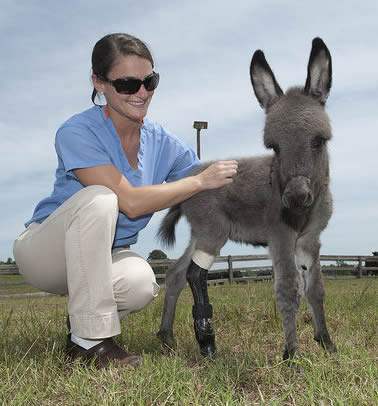 Work that successfully outfitted a miniature donkey with a prosthetic leg not only gave the animal a lease on life, but also carries implications for the rehabilitation of horses and other larger animals, say Auburn University animal researchers.
Work that successfully outfitted a miniature donkey with a prosthetic leg not only gave the animal a lease on life, but also carries implications for the rehabilitation of horses and other larger animals, say Auburn University animal researchers.
According to information from Auburn University, Emma, a miniature donkey, was brought to the John Thomas Vaughan Large Animal Teaching Hospital in April with severe hind limb deformity that required her right rear leg to be amputated.
Emma with her owner, Cece Smith. Emma has been treated at the Auburn University Large Animal Teaching Hospital since she was two days old.
(Photo courtesy of Auburn University) >>
The hospital began working with the Hanger Clinic, formerly Hanger Prosthetics and Orthotics, to develop a prosthetic for the animal. Austin, Texas-based Hanger is the company famous for making the prosthetic tail for Winter, the amputee dolphin and star of the film "Dolphin Tale."
Dr. Fred Caldwell, assistant professor in the Department of Clinical Sciences and an equine surgeon, worked with Billy Fletcher from the Hanger Clinic after the amputation.
"Billy was excited and enthusiastic to assist," Caldwell said. "Once we proceeded with the surgery and amputated the distal limb, he provided a small footplate to incorporate into the cast to even out the length of her hind limbs so she could bear weight until we could get the surgical site healed and have her fitted with prosthesis."
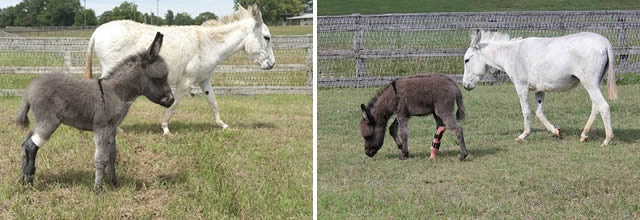
According to the university, Emma's treatment could have implications in the treatment and rehabilitation of horses, donkeys and other equids with congenital deformities or injuries.
It is uncommon to use prostheses with large equids because of their size and weight-bearing limitations. Emma is a miniature donkey and will grow to weigh 350 pounds as an adult.
She is now 11 weeks old and has done well with the prostheses.
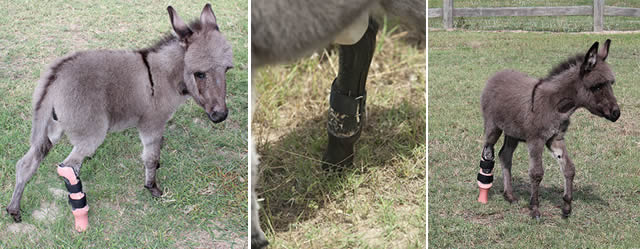
"She's absolutely loved it from the get-go," Caldwell said. "It was a very impressive design and she did very well in it. She has progressed to the second iteration of her prosthesis, which doesn't incorporate as much of the limb and allows her more range of motion. She is getting stronger; she's growing and doing wonderfully."
Fletcher, who sees patients in the Opelika and Columbus, Ga., Hanger Clinic locations said that as Emma grows, she could potentially go through eight or nine variations of the artificial limb before reaching full growth. At that point, she will be fitted with a piece that is more permanent.
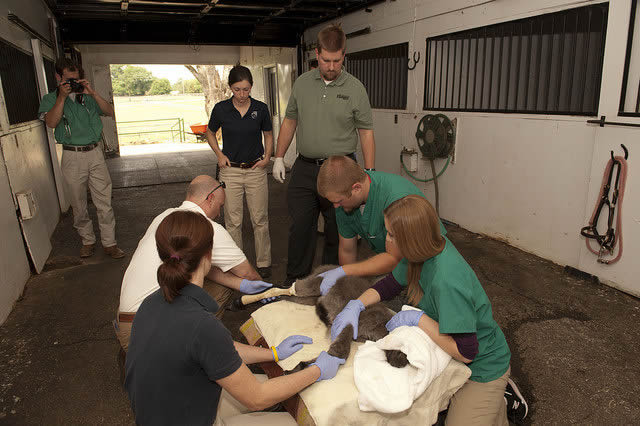
The prosthesis is made of carbon fiber, Kevlar and fiberglass, which are the same materials used for prostheses for Paralympic athletes. The first finished prosthesis weighed less than a pound and the most recent version, which is pink, is smaller but weighs a little more to provide stability as she's grown taller and almost doubled her weight since surgery.
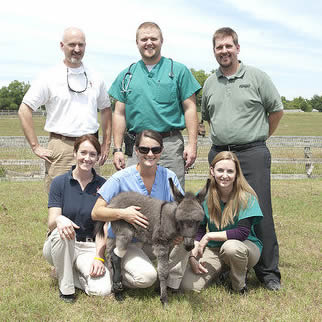 "The next step is trying to make sure we keep the prosthesis set up so she's ambulatory and she can run and play and do things uninhibited, but also, to keep the area of concern, the surgical site, offloaded so Dr. Caldwell can do his job in keeping her completely healed," Fletcher said.
"The next step is trying to make sure we keep the prosthesis set up so she's ambulatory and she can run and play and do things uninhibited, but also, to keep the area of concern, the surgical site, offloaded so Dr. Caldwell can do his job in keeping her completely healed," Fletcher said.
Caldwell said he has learned a lot from the case and it has given him hope that in the future, amputation and the use of such devices could be a feasible option for larger horse patients that suffer severe leg injury.
"Every opportunity we have with a case like this, I think we get a little closer to being able to consider this a viable option," he said. "It's been very educational for me as an equine surgeon to learn; this has certainly been my first case. I think we have a long way to go before we get to this being a procedure that's routinely an option for our larger patients, but for a prosthetic limb to be an option in horses is something that's pretty exciting."




